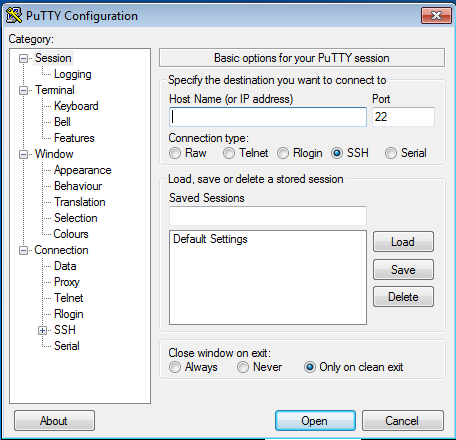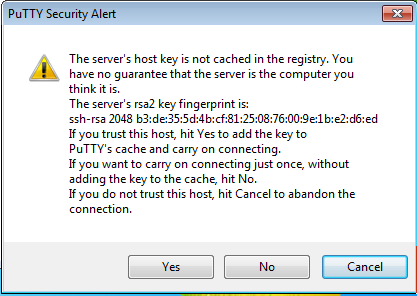5 Logging in to the Course Linux Server
All access to the Course Linux Server is through a network Remote Login. You will need your Algonquin 8-character userid (the same userid you use for Blackboard) and a special password (not your Blackboard password), and the network address of the server.
You must log in to the Course Linux Server using the remote terminal prococol SSH and you can transfer files using programs such as SFTP or SCP that use variations of the SSH protocol.
The CLS does not use your Algonquin network password. Your instructor can tell you your special Course Linux Server password. If you need your password reset, see your Linux instructor; do not go to ITS. Change your password when you first log in by typing the command name passwd. (Hey! Remember your password!)
You log in to this machine differently, depending on whether you are running a Unix/Linix/OSX/BSD/Cygwin system or a Windows system.
Choose the section below that corresponds to the system from which you are making the Remote Login connection:
- From Unix or Linux: Use any terminal window and
sshfor Unix/Linux. - From Apple Macintosh: Use the built-in
Terminalandsshon Apple Macintosh. - From Microsoft Windows: Use the PuTTY program.
If you have problems connecting (e.g. connection closed), try the Network Diagnostics.
5.1 Log in via SSH from Unix/Linux, Mac OSX, and Cygwin
For Windows users before Windows 10, scroll down to the Microsoft Windows PuTTY section.
Use this section if you are using a Unix/Linux command line:
- Apple Mac OSX systems have a Terminal program that lets you use SSH command lines.
- Microsoft Windows has an optional Cygwin environment with a BASH shell that lets you use SSH command lines.
- Microsoft Windows 10 lets you run some Linux commands, including SSH, using the optional new Linux shell subsystem.
To login to the Course Linux Server from the shell prompt at another Unix machine (including from Fedora, Ubuntu, SUSE, Knoppix, BSD, from a Macintosh OSX Terminal, from Windows Cygwin, or from the Windows 10 Linux subsystem), use an SSH command line similar to the one below.
5.1.1 SSH Via clserver
Use the model SSH command line below, with these notes:
Type your usual eight-character Algonquin userid (the same userid you use for Blackboard). Do not use
abcd0001! Replace the useridabcd0001, below, with your usual Algonquin userid. Your 8-character login userid must be all lower-case letters; do not use any capital letters.- Choose the correct host name in your SSH command below:
- On Campus address (school):
clserver
- On Campus address (school):
On your first connection, you will be asked to accept the server encryption key. Answer yes (use the full word) to accept the host key, if asked “Are you sure”.
Make sure the login banner says
COURSE LINUX SERVERwhen you connect! If this is not true, you are trying to log in to the wrong machine.If you use the correct host name and don’t see any banner but get an immediate disconnection, your IP address is probably locked out. See the section above on Getting locked out of the server.
When it asks for your password, use your special Course Linux Server password. The Course Linux Server does not use your Algonquin network or Blackboard password. The password will not echo as asterisks on your screen as you type it; you will be typing your password “blind”.
Your instructor can tell you your special Course Linux Server password. If you need your password reset, see your Linux instructor; do not go to ITS.
Your SSH command line will look similar to this (you must make the above changes first):
$ ssh abcd0001@clserver
Are you sure you want to continue connecting (yes/no)? yes
*** COURSE LINUX SERVER ***
abcd0001@clserver's password:
Welcome to Ubuntu 16.04.2 LTS (GNU/Linux 4.8.0-52-generic x86_64)
-bash-4.2$When you have logged in successfully, you will see a your CLS BASH shell prompt (default bash-4.2$). You can type Linux commands at this prompt.
When you are done with your session on the CLS, type exit to log out of the shell and close SSH. Do not simply close the Terminal program; always exit the shell first to avoid leaving behind a “ghost” login on the CLS. (“Ghost” logins do eventually time out and go away.)
5.1.2 SSH session time-out or broken pipe
If your SSH session times out or gets broken pipe errors, here is a suggestion from Oliver Bett:
Add the following line to your
/etc/ssh/ssh_configfile and it should keep the connection active.ServerAliveInterval 120I’ve set my interval to 120 seconds and seems to do the trick.
5.1.3 SSH using alternate Port numbers
The default SSH Port number is port 22. If you need to use a non-default Port number when connecting (your instructor will tell you this), specify the port number on the SSH command line using the -p option:
$ ssh -p 2222 abcd0001@some.example.comMake sure the login banner says COURSE LINUX SERVER when you connect! If this is not true, you are trying to log in to the wrong machine.
5.2 Log in via SSH from Windows using PuTTY
If you use Microsoft Windows, you can download and use the free PuTTY terminal program for Microsoft Windows. (You can also us any other SSH-capable program you like instead of PuTTY, but you’re on your own.) You may have to do an Internet search for PuTTY download and download and run the executable first: putty.exe
After you start PuTTY but before you open your PuTTY connection, make the PuTTY configuration changes given below and save them. Failure to make these configuration changes may result in your PuTTY session being disconnected in the middle (“Network error: Software caused connection abort”) and your session becoming inactive.
5.2.1 PuTTY Configuration options for Windows users
Before you connect using PuTTY the first time, you must set the following PuTTY Configuration options in the PuTTY Configuration dialog box. Read this whole section before you log in!
Failure to make the configuration changes below may result in your laptop keypad not working or your PuTTY session being disconnected in the middle (“Network error: Software caused connection abort”) and your session becoming inactive.

PuTTY Configuration Dialog Box
Category: Terminal:
Features (Enabling and disabling advanced terminal features)
Disable application keypad mode: ON
Category: Connection:
Seconds between keepalives: 55
Disable Nagle's algorithm: ON
Enable TCP keepalives: ON
Internet protocol version: IPv4
Category: Session:
Host Name (or IP address):* cst8207.idallen.ca (when off-campus, e.g. home) * OR clserver (when on campus at Algonquin) Connection type: SSH Port: 22 Saved Sessions: (choose your own name; see below)
After making the above configuration settings, save your settings using any name you choose:
- Go to the PuTTY Configuration dialog box Session Category.
- In the Session Category, enter a session name in the Saved Sessions box. You might choose the name on campus CLS for the on-campus host name, and off campus CLS for the off-campus host name.
- Use the Save button to save the session using the given name.
Save one configuration session that uses the off-campus Public host name and another configuration session that uses the on-campus host name that uses the Private IP address.
If you are on-campus at Algonquin College, you must connect to the CLS using the Private address clserver to avoid connection problems. The Private address only works on-campus at Algonquin College (or via the VPN).
Read the rest of this section to the end before you first Open a session. Your session will time out and become inactive if you don’t log in within a minute of clicking on Open.
Once you have saved both the on-campus and off-campus settings, choose the correct setting and use the Load button to load it, then use the Open button to start the session and connect to the CLS.
On your first connection, a PuTTY Security Alert dialog box will appear and you will be asked to accept the server’s host encryption key. Click on “yes”:

PuTTY Security Alert Dialog Box
Next, you will be prompted with the line login as: to enter your login userid. Type your usual eight-character Algonquin userid (the same userid you use for Blackboard). Do not use abcd0001! Replace the userid abcd0001, below, with your usual Algonquin userid. Your 8-character login userid must be all lower-case letters; do not use any capital letters.
Make sure the login banner says COURSE LINUX SERVER when you connect! If this is not true, you are trying to log in to the wrong machine.
If you use the correct host name and don’t see any banner but get an immediate disconnection, your IP address is probably locked out. See the section above on Getting locked out of the server.
When it asks for your password, use your special Course Linux Server password. The Course Linux Server does not use your Algonquin network or Blackboard password. The password will not echo as asterisks on your screen as you type it; you will be typing your password “blind”.
Your instructor can tell you your special Course Linux Server password. If you need your password reset, see your Linux instructor; do not go to ITS.
Your PuTTY session will look similar to this (you must make the above changes):
login as: abcd0001
*** COURSE LINUX SERVER ***
abcd0001@clserver's password:
Welcome to Ubuntu 16.04.2 LTS (GNU/Linux 4.8.0-52-generic x86_64)
-bash-4.2$When you have logged in successfully, you will see a bash-4.2$ shell prompt. You can type Linux commands at this prompt.
When you are done with your session on the CLS, type exit to log out of the shell and close PuTTY. Do not simply close PuTTY; always exit the shell first to avoid leaving behind a “ghost” login on the CLS. (“Ghost” logins do eventually time out and go away.)
Optional: If you have IPv6 connectivity at home, you can experiment using the IPv6 host name
ipv6.cst8207.idallen.caandInternet protocol version: IPv6to connect to the Course Linux Server.
5.2.2 Changing and saving PuTTY Configuration options
Using the mouse on the little screen icon in the top-left corner of your PuTTY session, you can bring down a menu that lets you change your PuTTY options for the current session. You can then re-save the changed settings to be available for your future sessions.
If you do not re-save the changes options, they will be lost and you will get the old settings when you re-start PuTTY.




